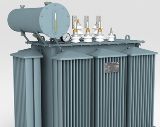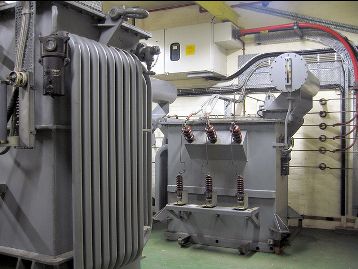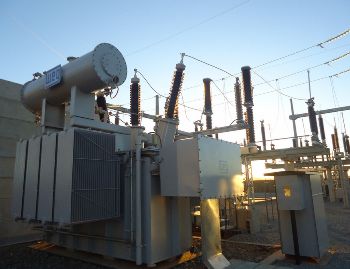Power transformers: rated operating modes and values
Nominal mode of operation
 The rated operating mode of the transformer is the mode for which the transformer was designed by the manufacturer. Determining conditions for the nominal mode of operation of the transformer are: nominal voltage, power, currents and frequency indicated on its nameplate, as well as the nominal conditions of the cooling medium.
The rated operating mode of the transformer is the mode for which the transformer was designed by the manufacturer. Determining conditions for the nominal mode of operation of the transformer are: nominal voltage, power, currents and frequency indicated on its nameplate, as well as the nominal conditions of the cooling medium.
Nominal voltage of the windings
The rated voltages of the transformer windings are those voltages at which they are designed for normal operation. For step-down transformers, the nominal voltages of the primary windings are equal to the nominal voltages of the corresponding electrical networks, i.e. electrical receivers.
For step-up and step-down transformers connected directly to the busbars or terminals of the generator, the rated voltages of the primary windings are 5% higher than the rated voltages of the corresponding mains.In secondary windings, rated is the phase voltage obtained at the terminals of the secondary windings of the transformer when it is no-load and when the rated primary voltage is applied to the terminals of the primary winding.
Exceeding the voltage supplied to the terminals of the main output or any branch of the primary winding is allowed not more than + 5% of the voltage indicated on the nameplate of the transformer for the main output or for this branch.
Rated strength
The rated power of a transformer is the power at which the transformer can be loaded continuously throughout its lifetime, usually assumed to be in the order of 20 — 25 years.
The nominal power of the transformer is related to the temperature conditions, that is, it depends on the permissible heating temperature of its windings, on the cooling conditions of the transformer, etc. Let's get acquainted with these temperature conditions in more detail.
Most transformers are oil cooled ("oil" transformers). In such transformers, the magnetic cores with windings are located in steel tanks filled with transformer oil, which is a mineral insulating oil derived from petroleum. The heat released in the windings and the magnetic core of the transformer during its operation is transferred with the help of oil to the medium cooling the transformer - air (air cooling) or water (water cooling).
For air-cooled oil transformers installed in areas where the highest air temperature reaches + 35 ° C, the average temperature rise of the windings above the air temperature should not exceed + 70 ° C (measured by the resistance method).For household transformers, the temperature rise of the windings, equal to + 70 ° C, corresponds to their nominal load. At an air temperature of + 35 ° C, the average heating temperature of the transformer windings is 70 ° + 35 ° = 105 ° C.
If during operation the heating temperature of the transformer windings is constantly maintained at + 105 ° C, then, as manufacturers' studies show, its service life will not exceed several years. However, at the rated load of the transformer, the heating temperature of the windings + 105 ° C will be constant only if the air temperature is constant, equal to + 35 ° C.
In reality, the ambient air temperature is never constant, but changes both during the day and throughout the year, which is why the heating temperature of the transformer windings varies in the range from + 105 ° C to some lower value. This naturally extends the service life of the transformer. Therefore, the above-mentioned maximum winding temperature + 105 ° C should be understood as the upper limit of the average temperature, measured by resistance, admissible for safe operation of the transformer for several hours a day during those relatively few days when the ambient temperature reaches maximum + 35 ° C.
In transformers without forced oil circulation, the largest temperature increase of the upper layers of oil (on the cover) above the ambient temperature should not exceed 60 ° C. At an ambient temperature of + 35 ° C, this corresponds to the most the high observed (by thermometer) oil temperature + 95 ° C.For transformers with forced oil circulation, for example with oil-water cooling, the oil temperature at the inlet of the oil cooler is allowed not higher than 70 ° C. For transformers with oil-air cooling, the maximum permissible oil temperature is determined from the manufacturer.

With that said, the rated power of the transformer should be understood as the power up to which a transformer installed outdoors can be permanently loaded, under nominal temperature conditions of the cooling medium, with air cooling, defined as the temperature of the air that varies naturally during the year. For other types of cooling, the nominal temperature conditions of the cooling medium are determined by the transformer manufacturers.
Note that previously the rated power of transformers installed outdoors was recalculated depending on the average annual temperature of the cooling air. As a result of recalculation, at an average annual ambient temperature of less than + 5 ° C, the nominal power of the transformer is increased, and at an average annual temperature above + 5 ° C, on the contrary, it is reduced.
Studies of the effect of oil viscosity on the cooling of transformers show that such a recalculation is not necessary, since at low air temperature the viscosity of the oil increases, as a result of which the heat transfer from the windings deteriorates and at elevated air temperature , on the contrary, the viscosity of the oil decreases, and the heat transfer from the transformer windings increases.
In addition to outdoor installations, air-cooled transformers are often placed in closed unheated rooms — chambers, in which natural ventilation is usually provided with the supply of cold air and the removal of heated air through special ventilation holes in the lower and upper parts of the chamber, respectively . Despite the ventilation, the cooling conditions of the transformers in the chambers are still worse than those installed outdoors, which somewhat reduces their service life. However, transformers installed in chambers with natural ventilation can be charged continuously at their rated power at average annual chamber air temperatures of up to 20 °C.
Nominal currents of the primary and secondary windings of the transformer are called currents determined by the nominal powers of the respective windings.
Under nominal load understanding the load equal to the nominal current.
In the mode of operation of the transformer without overload at any position of the switch, as well as for any values of the voltage supplied to the primary winding (but not higher than + 5% of the voltage value of this tap), the secondary winding of the transformer can to be loaded no higher than the rated current.

